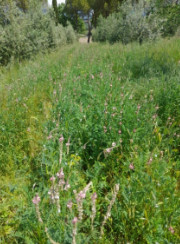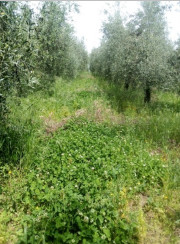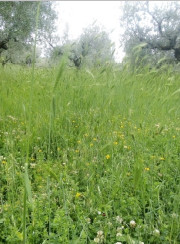CREA, Italy
Field experiments
Introducing legumes as cover crops in olive orchards could be a strategy to reduce the use of external inputs, improve long-term sustainability and increase crop diversity to stabilize or enhance crop yields under climate change. The trial was conducted in three different olive farms, located in Umbria, a region in central Italy.
Perennial species were chosen for testing in the different farms, because they do not need to be sown each year. They are also locally adapted legumes that are known to perform well in the area, even if they are usually not cultivated under olive trees.

Figure 1 – The three sites of the farm trials. The three farms are indicated as follows: Farm 1 = Spoleto; Farm 2 = Spello; Farm 3 = Assisi.
Studied crops



Figure 2 – Flowering of sainfoin (Onobrychis viciifolia) on Farm 1 (left), of white clover (Trifolium repens) on Farm 2 (center), and of the mix of white clover + bird’s-foot trefoil (Lotus corniculatus) on Farm 3 (right) as legumes cover crops in the olive orchard.
Results
Main experimental results
On Farm 1, there were four treatments: white clover (Trifolium repens), sainfoin (Onobrychis viciifolia), bird’s-foot trefoil (Lotus corniculatus) and spontaneous cover (control). On Farm 2, in addition to those already mentioned, there were also sulla (Hedysarum coronarium), and a tillage treatment, following the traditional management. On farm 3, there were only two treatments, one with spontaneous cover (control) and one with a sown mixture of white clover + bird’s-foot trefoil (legumes mix). All treatments (except tillage) were mowed by mechanical mowing.
The highest cover crop aboveground biomass values were recorded on Farm 1 in May (about 2500 kg dry matter ha-1).
Intercropping legume cover crops in olive orchards increased the amount of nitrogen in the soil as well as, in some cases, in the olive leaves, without depleting the soil water content compared to both spontaneous covers and tilled soil. In addition, it increased agroecosystems biodiversity and produces good quality forage under the trees.
Farmers’ feedback
Farmers were in general satisfied with the biomass production provided by the legume cover crops in the first year, but disappointed that the following year the biomass was reduced and by the third year there was virtually no biomass from the sown legumes, despite the perennial nature of the species used. This entails a limited benefit for the investment, or a re-sowing rate that is too frequent and expensive. Future trials might consider other species, perhaps better able to either survive longer, or re-seed themselves. In this respect, annual self-reseeding species tested might be more successful, pending gathering the data on their survival and re-seeding rate.
Despite the limited persistence of the tested species, the fact that water competition among cover crop and trees did not seem to affect soil moisture in a significant way, while soil and leaf N may be enhanced, appeared to be interesting aspects of the innovations tested. With the raising costs of fertilizers and the increasing limitations in input use, especially in organic farming, the fertilization aspect of legumes is increasingly appealing.
The stakeholders interviewed were interested in understanding that the environmental and socio-economical analysis of the olive-wild asparagus innovation proved positive, and that the system appears to be economically attractive. The additional labor required and the need for marketing a new product (asparagus spears) might however slow down the possible adoption. Nonetheless, several other farmers in the area have expressed interest in trying out the innovation and some already planted some wild asparagus plants.
Modelling results

Involving stakeholders in early assessment stages increases approach robustness.
Olive-asparagus intercropping is an innovative, promising agroforestry system.
Olive-asparagus is more productive compared to sole cropping.
Olive-asparagus has positive net present value, despite price drops and high costs.
Links to relevant practical abstracts, relevant papers…. Produced in the project
One practical abstract on olive intercropping.
One paper being submitted on Olive-Wild asparagus socio-economic analysis (Refer to WP5 leaders).
One paper on asparagus yield under olive trees: https://link.springer.com/article/10.1007/s10457-023-00860-0
One book chapter on olive agroforestry, In: “The Olive: Botany and Production” (Fabbri, Baldoni, Caruso, Famiani eds). https://www.cabidigitallibrary.org/doi/book/10.1079/9781789247350.0000amiani eds). https://www.cabidigitallibrary.org/doi/book/10.1079/9781789247350.0000
